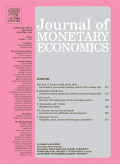
JOURNAL OF MONETARY ECONOMICS
Scope & Guideline
Navigating the Landscape of Monetary Economics
Introduction
Aims and Scopes
- Monetary Policy Dynamics:
Explores the implications of various monetary policy frameworks and their effectiveness in achieving macroeconomic stability, including interest rate adjustments, quantitative easing, and forward guidance. - Financial Market Interactions:
Investigates the interactions between monetary policy and financial markets, including the effects of central bank actions on asset prices, credit risk, and market liquidity. - Behavioral Economics and Expectations:
Analyzes how consumer and firm expectations shape economic outcomes, focusing on topics such as inflation expectations, uncertainty, and the psychological aspects of decision-making. - Macroeconomic Impacts of Structural Changes:
Examines the broader macroeconomic implications of structural changes, including labor market dynamics, technological advancements, and demographic shifts. - International Monetary Relations:
Studies the effects of globalization on monetary policy and financial stability, including cross-border capital flows, exchange rates, and international coordination of monetary policy. - Empirical and Theoretical Modeling:
Utilizes both empirical and theoretical approaches to develop models that capture the complexities of monetary economics, often employing advanced statistical techniques and simulations.
Trending and Emerging
- Digital Currencies and Fintech:
Research on central bank digital currencies (CBDCs) and the implications of fintech innovations is gaining traction, reflecting the rapid changes in the financial landscape and the need for adaptation in monetary policy. - Behavioral Insights on Inflation Expectations:
There is an increasing focus on the behavioral aspects of inflation expectations, exploring how psychological factors influence consumer behavior and economic outcomes. - Macroprudential Policies:
The study of macroprudential regulation is becoming more prominent as scholars explore the interplay between monetary policy and financial stability, particularly in the context of recent financial crises. - Globalization and Monetary Policy Spillovers:
Emerging research is addressing the complexities of globalization and its effects on national monetary policies, including spillover effects and coordination challenges. - Inequality and Monetary Policy:
There is a notable trend towards examining the relationship between monetary policy and income inequality, exploring how different monetary strategies can impact wealth distribution. - Sustainability and Climate Considerations:
Research addressing the intersection of monetary policy with environmental sustainability and climate change is emerging, highlighting the role of central banks in addressing these critical global challenges.
Declining or Waning
- Traditional Macroeconomic Models:
There appears to be a waning interest in classical macroeconomic models that do not incorporate modern complexities such as behavioral factors or financial frictions, as researchers increasingly focus on more dynamic and realistic frameworks. - Simple Monetary Policy Rules:
The focus on basic monetary policy rules, such as the Taylor rule, has diminished as the discourse shifts towards more nuanced approaches that consider the complexities of real-world economic behavior. - Static Analysis of Economic Phenomena:
Research employing static analytical frameworks is decreasing, with a growing preference for dynamic models that account for time-varying behaviors and structural changes in the economy. - Homogeneity in Economic Agents:
The assumption of homogeneous agents in economic modeling is becoming less favored, as the literature increasingly emphasizes heterogeneity and the diverse behaviors of different economic actors. - Short-term Focus on Monetary Policy:
There is a decline in papers focusing solely on the short-term effects of monetary policy, with a shift towards understanding long-term implications and interactions with fiscal policy.
Similar Journals
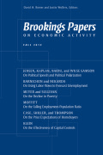
BROOKINGS PAPERS ON ECONOMIC ACTIVITY
Advancing Knowledge in Economic Activity.BROOKINGS PAPERS ON ECONOMIC ACTIVITY, published by Johns Hopkins University Press, stands at the forefront of economic research, providing critical insights and analysis across the fields of economics and econometrics. With a prestigious Q1 ranking in both the Business, Management and Accounting (miscellaneous) and Economics and Econometrics categories for 2023, this journal is renowned for its scholarly contributions that shape public policy and debates within the economic community. Since its inception, the journal has consistently published high-impact research and innovative discussions surrounding economic activity, making it an essential resource for researchers, professionals, and students alike. Although it does not offer open access, its academic rigor and relevance continue to attract a broad readership, contributing to a deeper understanding of economic phenomena in the United States and beyond. For more information, visit the journal’s homepage or the Johns Hopkins University Press website.
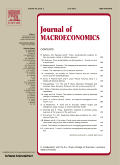
JOURNAL OF MACROECONOMICS
Exploring the Dynamics of Global EconomiesJOURNAL OF MACROECONOMICS, published by Elsevier, stands as a significant platform for scholarly discourse in the field of economics and econometrics. With an ISSN of 0164-0704 and an E-ISSN of 1873-152X, this journal has been actively contributing to the academic community since 1979 and continues to publish impactful research through 2024. It is recognized within the Q2 category for Economics and Econometrics in its 2023 quartile rankings, and it holds a respectable Scopus ranking of #353 out of 716 in its field, placing it in the 50th percentile. Despite not being an open-access journal, it provides valuable insights into macroeconomic theories, empirical assessments, and policy implications, making it an essential resource for researchers, professionals, and students aiming to deepen their understanding of macroeconomic dynamics. To access a breadth of contemporary research and enhance your academic pursuits, consider diving into the latest issues of this esteemed journal, conveniently located in Amsterdam, Netherlands, at RADARWEG 29, 1043 NX.

Journal of Central Banking Theory and Practice
Fostering Research Excellence in Financial StabilityThe Journal of Central Banking Theory and Practice, published by SCIENDO, is a leading open-access journal that has been providing valuable insights into the realms of central banking, monetary policy, and financial stability since its inception in 2012. With its ISSN 1800-9581 and E-ISSN 2336-9205, this journal emphasizes rigorous scholarly research, catering to a wide audience of economists, finance professionals, and academic researchers. Based in Germany, the journal has established a strong reputation, evident from its improved category quartiles - moving from Q3 in Economics, Econometrics, and Finance to a commendable Q2 in 2023. With an impressive Scopus rank of #83/288 in General Economics and a 71st percentile ranking, it stands as a pivotal resource for understanding current trends and practices in central banking. Authors are encouraged to submit high-quality, original research that fosters knowledge and advances the field. This journal not only disseminates significant findings but also promotes discussions that are critical for policymakers and stakeholders in the financial sector.
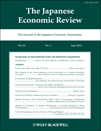
JAPANESE ECONOMIC REVIEW
Fostering scholarly dialogue on Asia-Pacific economic processes.Japanese Economic Review, published by Springer Heidelberg, is a renowned academic journal that aims to advance the understanding of economic processes within the context of Japan and the Asia-Pacific region. With an ISSN of 1352-4739 and E-ISSN of 1468-5876, this journal features high-quality research articles that span a broad range of topics in economics and econometrics. Ranked in the Q2 category for Economics and Econometrics as of 2023, it holds a Scopus rank of #332 out of 716, placing it in the 53rd percentile among its peers. Although not Open Access, the journal invites contributions that provide insights and empirical analyses beneficial to both academics and practitioners. Emphasizing a deep understanding of economic dynamics, the Japanese Economic Review is essential reading for anyone interested in the implications of economic policies and trends, making it a significant platform for scholarly dialogue and research dissemination.

JOURNAL OF INTERNATIONAL MONEY AND FINANCE
Navigating the complexities of international monetary dynamics.JOURNAL OF INTERNATIONAL MONEY AND FINANCE is a premier scholarly publication dedicated to advancing the understanding of international finance and monetary economics. Published by Elsevier Science Ltd, this esteemed journal has been disseminating critical research since its inception in 1982 and will continue to contribute to the field through 2024. With a strong international presence and headquarters in the United Kingdom, the journal boasts an impressive collection of articles that explore significant trends, challenges, and innovations in the areas of economics and finance. Recognized for its impact, it ranks in the top quartile (Q1) in both the Economics and Econometrics and Finance categories as of 2023, signifying its influence and relevance among peers. Researchers, professionals, and students in these disciplines can benefit from the journal's rigorous peer-review process, ensuring high-quality scholarly outputs. Though not currently an open-access journal, it provides various subscription options to foster access to groundbreaking research in the financial ecosystem.
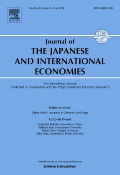
JOURNAL OF THE JAPANESE AND INTERNATIONAL ECONOMIES
Connecting Scholars to Global Economic TrendsJOURNAL OF THE JAPANESE AND INTERNATIONAL ECONOMIES, a prestigious publication from Academic Press Inc. Elsevier Science, has been a vital contributor to the fields of economics, finance, and political science since its inception in 1987. With an impressive impact factor and recognized within the Q2 category for Economics and Econometrics as well as Finance, and Q1 for Political Science and International Relations, this journal serves as a critical platform for peer-reviewed research that influences both academic discourse and policy-making. The journal is indexed in Scopus, evidencing its prominent position within the scholarly community, with notable rankings of #56 in Political Science and #72 in Finance. Authors and researchers are encouraged to submit their work, contributing to the rich tapestry of knowledge surrounding the economic dynamics of Japan and the broader international landscape. Though it does not offer open access, the journal's subscription model ensures a wide dissemination of its impactful articles, making it essential reading for those aimed at deepening their understanding of economic interrelations and current global issues.
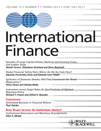
International Finance
Exploring the nexus of finance and development.International Finance is a prestigious academic journal published by WILEY, dedicated to the exploration and advancement of theories and practices in the realms of finance, development, and geography. With a strong emphasis on empirical and theoretical research, this journal provides a crucial platform for researchers, professionals, and students to disseminate cutting-edge findings that shape our understanding of the financial landscape on a global scale. Holding an impressive impact factor and categorized in the Q2 quartile across multiple disciplines, including Development, Finance, and Geography, the journal has established itself as a significant contributor to scholarly discourse. Since its inception in 1998 and spanning until 2024, International Finance offers a comprehensive overview of current trends and challenges faced in financial contexts, enhancing the decision-making processes within academia and industry alike. Although the journal is not open access, its rigorous peer-review process guarantees high-quality content that is indispensable for anyone engaged in the diverse fields intersecting with finance.

American Economic Journal-Macroeconomics
Unraveling Complexities of Economic DynamicsAmerican Economic Journal-Macroeconomics, published by the American Economic Association, stands at the forefront of economic research, addressing pivotal macroeconomic issues that shape global economies. With an impressive Scopus rank of #8 out of 288 in its field and a notable 97th percentile ranking, this journal is widely regarded as a top-tier publication, specifically categorized in the Q1 category for Economics, Econometrics, and Finance as of 2023. Operating under ISSN 1945-7707 and E-ISSN 1945-7715, it aims to disseminate high-quality research from 2009 through 2024 and beyond, providing crucial insights into macroeconomic theory and policy. Although the journal currently does not operate under an open access model, it remains a vital resource for researchers, economists, and students seeking to deepen their understanding of macroeconomic dynamics and their implications for economic policy worldwide. The journal's impactful contributions make it an essential read for those striving to influence economic thought and practice.
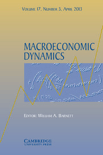
MACROECONOMIC DYNAMICS
Elevating Understanding of Economic Trends and ImpactsMACROECONOMIC DYNAMICS, a distinguished academic journal published by Cambridge University Press, serves as a pivotal platform for innovative research in the fields of economics and econometrics. With its ISSN 1365-1005 and E-ISSN 1469-8056, the journal has been at the forefront of scholarly communication since its inception in 1997, offering an extensive range of articles that explore dynamic economic models, policy impacts, and theoretical advancements through the latest empirical analyses. Currently holding a Q2 ranking within the 2023 Economics and Econometrics category, and positioned at rank #409 out of 716 within Scopus, it is an essential resource for researchers, professionals, and students alike, looking to stay updated on critical developments in macroeconomic theory and practice. Although it follows a traditional subscription model rather than Open Access, the journal continually strives to disseminate high-quality, peer-reviewed content that informs and inspires the global economics community. The importance of MACROECONOMIC DYNAMICS lies in its commitment to fostering a deeper understanding of economic phenomena, making it a must-read for anyone engaged in the complexities of the economic landscape.

Eurasian Economic Review
Exploring the dynamics of Eurasian economies.Eurasian Economic Review is a premier academic journal dedicated to the dissemination of high-quality research in the field of economics, notably within the Eurasian context. Published by SPRINGER HEIDELBERG in Switzerland, this journal stands out with an impressive Q2 ranking in the 2023 category of Economics, Econometrics and Finance, reflecting its influential role in fostering scholarly dialogue. The journal encompasses a broad array of topics related to economic trends, policy impacts, and theoretical advancements, making it an essential resource for researchers, professionals, and students alike. With a consistent output since its inception in 2011, the Eurasian Economic Review is committed to providing open access to its valuable content, ensuring that important findings are widely available to the global research community. As a member of the top 9th percentile in Scopus rankings for its field, this journal uniquely positions itself as a vital conduit for innovative and impactful research in economics.